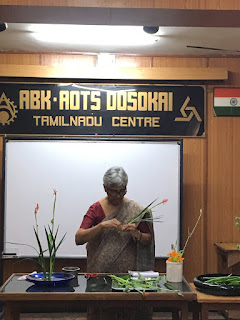Tuesday 18th December 2018
Japanese Narcissus is a traditionally loved material by Ikebana artists in Japan, and is used in early spring arrangements. Book 5 shows the technique of hagumi, to arrange these flowers and their lanceolate leaves. Sensei Molly Cherian took on the task of demonstrating this style using materials available locally in her garden. She explained that she was fascinated by the lily family, and the arrangements of Narcissus, and wanted to replicate the effect.
Using Yucca leaves and Canna flowers from her garden she showed us the process of disassembling the inner leaves and then reassembling it in the way the artists wants it. Eleven of us watched with fascination as sensei Molly showed the removal of the hakama (sheath) and she worked with deftness in putting back the leaves in the manner in which she wished, inserting back into the hakama, before placing it in the vase.
 |
This was the first composition, with Canna and Yucca leaves, and duranta leaves lower down.
The leaves are arranged in a circular fashion, and she chose to show the water which is
part of the composition. |
 |
Her second composition was in a larger suiban, using Sans savera leaves and gladioli flowers in
a kabuaki style. |
Her arrangements were elegant and pleasing, and in true Ikebana style we were drawn to observe and enjoy the lines and interplay of the leaves with one another, and the water and container.
In the workshop, members used the lanceolate leaves of lily family, though unable to try the typical hagumi method with the hakama.
 |
Sensei Padma used Gladioli with Amaryllis leaves, and it was lovely
to see the turns of each leaf. |
 |
Sensei Ambika worked with Amaryllis lilies and leaves, from her garden, using the dry and young leaves to
recreate her mental picture of the pot in her garden. |
 |
Sensei Molly used water hyacinth leaves with Asia Lily flowers in
a third arrangement. |
 |
Chitra Rajan called this the Dance of spring - Birds nest, angelonium, canna indica and plumbago.
Ceramic moribana tray |
 |
Jyotsna use the flowers, pods and leaves of Canna, complementing
the fiery red of the inner surface of the container. |
Sensei Trishala experimented with twin vases and a single vase with orchids and lily leaves.
 |
| Bhuvana used Kale and spider lily leaves, with a Gladioli flower |
 |
Pushkala recreated a pond scene with Oleander flowers and lily leaves beautifully
balancing the driftwood. |
 |
Sensei Malathi used Bird's Nest fern for lance shaped leaves in its natural form and
vinca rosa bereft of its leaves, from her garden. She placed them as she saw them,
growing together |
 |
| Sensei Prerana created a festive feel |
 |
Chelvi used the spring onion leaves which also have the sheath, and created a
morimono with cauliflower and Kale! |
Tucking into seklas from Prerana, Mysore pak from Pushkala and refreshing fruit juice from Jyotsna, it was a satisfying end to the workshop, and to 2018.
Happy New year to all our readers!
















Comments